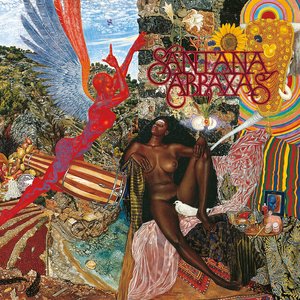Published on Apr 26, 1997
Too often these days, I’m seeing bands from the Woodstock
generation being destroyed by their greatest enemy – time.
Some bands like Quill were almost immediately forgotten after
all the garbage was picked up from Max Yasgur’s farm. Others, like
Ten Years After, have just been forgotten by time.
Then there is the story of Santana. Coming from out of nowhere,
they made a big splash at Woodstock, and then went on to release
their at-the-time groundbreaking second disc,
Abraxas. But what was special (and, judging from the
painting of the naked woman on the cover, controversial) in 1970 is
tired and weak in 1997.
Oh, sure, the two hits off this one are still very enjoyable.
“Black Magic Woman,” the cover of the Fleetwood Mac song, still
blows me away, and is some of Carlos Santana’s best guitar playing.
The merge into “Gypsy Queen” adds a Latin flavor to the track that
sounds like it belonged there all the time. And Tito Puente’s “Oye
Como Va” is great, though I wish that Santana had just cut loose on
this one instead of playing more controlled, rhythmic solos.
But the remainder of
Abraxas seems to rely on creating a Latin feel to the music
rather than letting the music do the talking. The organ of Gregg
Rolie sounds incredibly dated, and even on a cut like “Oye Como
Va,” is simplistic to the point of annoyance. Where he could have
been making a unique voice in the background during the chorus, he
ssticks to a “duh-duh—duh-duh-duh” rhythm (hey,
you try to make organ noises without a keyboard) that sounds
so out of place in that portion of the song.
The opening track, “Singing Winds, Crying Beasts,” tries to set
a gentle mood, but the jazz feel of the song sounds forced,
distracting from the performance. Luckily for Santana, they follow
this up with the two classic-rock hits previously talked about.
The rest of
Abraxas then falls into shambles. “Incident At Neshabur” is
the closest the band comes to cohesiveness, though even this tends
to ramble. The remaining tracks, including “Se A Cabo,” “Samba Pa
Ti” and “El Nicoya” fail to light the speakers on fire the way
Santana did in his band’s brief set at Woodstock.
And the two Rolie compositions, “Mother’s Daughter” and “Hope
You’re Feeling Better,” don’t help matters much. I don’t know if
the problem is the songwriting or a poor attempt at adding a rock
flavor to the Latin rhythms, but these two tracks fall apart
quickly.
It’s not that I’m against Latin music; I think Gypsy Kings are
one of the genre’s most underrated bands, and I often put one of
their discs in one of the players scattered throughout the Pierce
Memorial Archives whenever I need a pick-me-up. But Santana, from
all of my recollections, has been spotty on vinyl, and
Abraxas is no exception.
And Santana’s guitar playing has its moments, but from what I
hear on this one, it sounds like he’s more comfortable in the role
of rhythm guitarist. His leads lack the development of many other
players, tending to concentrate on just a limited range of notes.
Even that wouldn’t be so bad, if he could make them do more than
just plink away on the track.
The band will live in the hearts of classic rock fans for “Black
Magic Woman,” and for good reason, but
Abraxas is a relic of time that is better left to the
ages.
